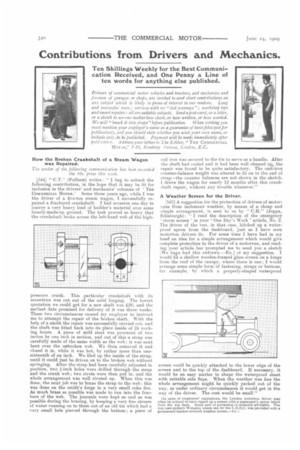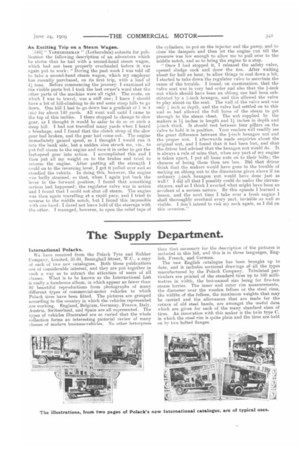Contributions from Drivers and Mechanics.
Page 30

Page 31

If you've noticed an error in this article please click here to report it so we can fix it.
Ten Shillings Weekly for the Best Communication Received, and One Penny a Line of ten words for anything else published.
Drivers of commercial motor vehicles and tractors, and mechanics and foremen of garages or shops, are invited to send short contributions on any subject which is likely to trove of interest to our readers. Long and successful runs ; services with no "lost journeys" ; workshop tips and smart repairs : all are suitable subjects. Send a post-card, or a letter, or 4 sketch to us—no matter/row short, or how written, or how worded. We will "knock it into shape" before publication. When writing you must mention your employer's name as a guarantee of bona fides (not for publication), and you should state whether you wish your own name, or initials only, to be published. Payment will be made immediately after pIebVralirn. Address your letters to The Editor, " THE COMMERCIAL MOTDR," 7-75, Rosebery A Venue, 1.anclon, E.C.
How the Broken Crankshaft of a Steam Wagon was Repaired.
The sender of the following communication has been awarded the Ms. prize this week.
[544] " C.T." (Fulham) writes " I beg to submit the following contribution, in the hope that it may be fit for inclusion in the drivers' and mechanics' columns of THE COMMERCIAL MOTOR.' Some three years ago, while I was the driver of a five-ton steam wagon, I successfully repaired a fractured crankshaft. I had occasion one day to convey a very heavy load of builder's material over some loosely-made-up ground. The task proved so heavy that the crankshaft broke across the left-hand web of the high pressure crank. This particular crankshaft u ith its eccentrics was cut out of the solid forging. The lowest quotation we could get for a new shaft was £20, and the earliest date promised for delivery of it was three weeks. These two circumstances caused my employer to instruct me to attempt the repair of the broken shaft. With the help of a smith the repair was successfully carried out, and the shaft was fitted back into its place inside of 24 working hours. A piece of mild steel was procured of two inches by one inch in section, and out of this a strap was carefully made of the same width as the web ; it was next bent over the unbroken web. We then removed it and closed it in, while it was hot, by rather more than onesixteenth of an inch. We filed up the inside of the strap, -until it could just be driven on to the broken web without springing. After the strap had been carefully adjusted in position, two t-inch holes were drilled through the strap and the crank web; two rivets were then put in, and the whole arrangement was well riveted up. When this was done, the next job was to braze the strap to the web this was done on the smith's forge in a very small coke fire. As much brass as possible was made to run into the fracture of the web. The journals were kept as cool as was possible during the brazing, by keeping a very fine stream of water running on to them out of an old tin which had a 'very small hole pierced through the bottom; a piece of
rod iron was secured to the tin to serve as a handle. .After the shaft had cooled and it had been well cleaned up, the repair was found to be quite satisfactory. The cast-iron counter-balance weight was altered to fit on to the end of strap—the counter balances are not shown in the sketch. I drove the wagon for nearly 12 months after this crankshaft repair, without any trouble whatever."
A Weather Screen for the Driver.
5451 A suggestion for the protection of drivers of motorvans from inclement weather, by means of a cheap and simple arrangement, is sent to us by " C.H." (Joppa, Edinburgh): " I read the description of the emergency storm screen ' in your One Day's Work ' article, No. 2. The driver of the van, in that case, hitched up a waterproof apron from the dashboard, just as I have seen motorbus drivers do. For some time I have had in my head an idea for a simple arrangement which would give complete protection to the driver of a motorvan, and reading your article has prompted me to send you a sketch LWe hare had this redrawn.—ED.] of my suggestion. I would fix a shallow wooden-framed glass screen on a hinge from the roof of the canopy, where there is one; I would arrange some simple form of fastening, straps or buttons, for example, by which a properly-shaped waterproof screen could be quickly attached to the lower edge of the screen and to the top of the dashboard. If necessary, it would be an easy matter to shape the waterproof sheet with suitable side flaps. When the weather was fine the whole arrangement might be quickly packed out of the way, as under ordinary circumstances it would get in the way of the driver. The cost would be small."
[In spite of employers' regulations, the London motorbus driver may often be noticed to have rigged up a screen with a passenger's apron taken from the top deck. Some sort of protection is certainly advisableThe first new-pattern Wolseley which ran for the L.0.0.0. was provided with a permanent leather-covered weather screen.—ED. J
An Exciting Trip on a Steam Wagon.
5-16] " YORKSHIREMAN " (Lothersdale) submits for publication the following description of an adventure which he states that he had with a second-hand steam wagon, which had not been properly overhauled before it was .11 gain put to work: "During the past week I was told off to take a second-hand steam wagon, which my employer has recently purchased, on its first trip, with a load of 41 tons. Before commencing the journey; I examined all the visible parts but I took the last owner's word that the other parts of the machine were all right. The route, on which I was to travel, was a stiff one; I knew I should have a lot of hill-climbing to do and some steep hills to go down. One hill I had to go down has a gradient of 1 in 4 (sic) for about 140 yards. All went well until I came to the top of this incline. I there stopped to change to slow gear, as I thought it would be safer to do so on such a steep hill. I had not travelled many yards when I heard a breakage, and I found that the clutch strap of the slow gear had broken, and the gear had come out. The engine immediately gained speed, so I thought I would run it into the bank side, but a sudden idea struck me, viz., to put full steam to the engine and race it in order to get the fast-speed gear into action. I accomplished this and I then put all my weight on to the brakes and tried to reverse the engine. After putting all the strength I could on to the reversing lever, I got it pulled over and so steadied the vehicle. In doing this, however, the engine was badly strained, so that, when t again put back the lever to the forward position, I found that something serious had happened; the regulator valve was in action 'and I found that I could not shut off steam. The engine was then again travelling at a rapid pace, and I tried to reverse to the middle notch, but I found this impossible with one hand : I dared not leave hold of the steerage with the other. I managed, however, to open the relief taps of the cylinders, to put on the injector and the pump, and to close the dampers and then let the engine run till the pressure was low enough to allow me to pull over to the middle notch, and so to bring the engine to a stop. " Once I had stopped it, I released the safety valve, opened sludge cock and drew the fire. After waiting about for half an hour, to allow things to cool down a bit, I started to take down the regulator valve to ascertain the cause of the trouble. I found, on examination, that the valve seat was in very bad order and also that the Finch nut which should have been an oblong one had been substituted by a Finch hexagon, and this allowed the valve to play about on the seat. The wall of the valve seat was only inch in depth, and the valve had settled on to this and so had allowed the full force of the steam to get through to the steam chest. The nut supplied by the makers is 1i inches in length and 1i inches in depth and Finch thick. Tt should rest between four pillars on the valve to hold it in position. Your readers will readily see the great difference between the Finch hexagon nut and the proper nut. I afterwards made enquiries about the original nut, and I found that it had been lost, and that the driver bad advised that the hexagon nut would do. It is always a rule of mine that, when any part of my engine is taken apart. I put all loose nuts on to their bolts; the chances of losing them then are less. Did that driver think that the makers would have gone to the trouble of making an oblong nut to the dimensions given above if an ordinary ,-inch hexagon nut would have done just as well I' I did all that I possibly could do under the circumstances, and so I think I averted what might have been an accident of a serious nature. By this episode I learned a lesson, and the next time I take over a fresh engine 1 shall thoroughly overhaul every part, invisible as well MS visible. I don't intend to risk my neck again, as I did on this occasion."
































